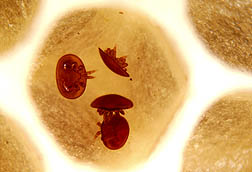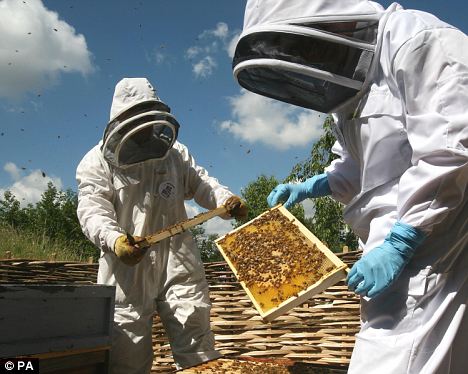
Breadcrumbs
Selecting Queens
Several races and hybrids of the honey bee, Apis mellifera, are available from queen producers. You can select the race or hybrid that best suits your beekeeping style, location and goals. Most commonly available races are: Italian, Carniolan, Caucasian and German Black. Most common hybrids are Midnight, Starline, Buckfast, and Yugo. There are others that are less common, not as available or little is known of their background or performance. It is good practice to ask the producer for any special information or date about queens produced; often a breeding program takes a back seat to simply producing queens for sale.
ITALIAN. The most commonly available race, Apis mellifera ligustica originated on the Italian peninsula, the only European bee with yellow pigmentation. They are short distance foragers, which means they are prone to robbing. They orient on color, so long rows of white colonies lend to drifting. Moderate spring buildup, peak summer populations and slow to shut down in fall can mean lots of winter bees - with the honey stores necessary for that. Low swarming is good, but can be temperamental.
CAUCASIAN. Apis mellifera caucasica evolved in the Caucas mountains near the Black Sea. Predominately dark, with gray or brown spots. Drones have dark hair, and queens are dark, harder to find. They are gentle, quiet on the combs and slow to build in the spring. Little swarming. Produces lots of propolis, but shut down early in the fall. They winter well.
CARNIOLAN. Apis mellifera carnica evolved in Austria and Yugoslavia, and most of Europe. The Yugo bee is of Caniolan descent. Build rapidly in the spring, they are heavy swarmers. Dark, with dark gray hair with some brown. Dark queens shut down in derths and early in fall. Calm and gentle, they forage in marginal weather. Robbing, drifting minimal.
BUCKFAST. A hybrid of several races, selected for gentleness, wintering, production and tracheal mite resistance. Available from Weaver Apiaries and some other outlets. Variable in appearance, queens tend toward leather. Moderate fast spring buildup, peak in early summer, good producers. Low swarming.
STARLINE. A hybrid of several stocks, all Italian. Fast spring buildup, lots of brood early means terrific honey production. Very uniform in appearance, they are slow to shut down in fall. Good commercial bee.
MIDNIGHT.A Carniolan/Caucasian cross. Moderate spring buildup, dark to dark gray, dark queens. Good in marginal weather and extremely gentle. Shuts down early in fall, winters well.
GERMAN BLACK. Apis mellifera mellifera. First bee in U.S., still very prominent in feral populations. Small, dark and mean. Very susceptible to foulbrood, but a survivor bee in many areas affected by Varroa and invasion of Africanized bees.
AFRICANIZED BEES(Apis mellifera scutellata) have taken up residence in the southern reaches of Texas, Arizona, New Mexico and California. These are undesirable bees because of their defensiveness and are not raised for sale.
U.S. Honey Bee Losses
The total number of managed honey bee colonies has decreased from 5 million in the 1940s to only 2.5 million today. At the same time, the call for hives to provide pollination services has continued to increase. This means honey bee colonies are being transported over longer distances than ever before.
 Declines in honey bee colony health were exacerbated in the 1980s with the arrival of new pathogens and pests. The arrival of Varroa and tracheal mites into the United States during the 1990s created additional stresses on honey bees.
Declines in honey bee colony health were exacerbated in the 1980s with the arrival of new pathogens and pests. The arrival of Varroa and tracheal mites into the United States during the 1990s created additional stresses on honey bees.
Colony losses from CCD are a very serious problem for beekeepers. Annual losses from the winter of 2006-2011 averaged about 33 percent each year, with a third of these losses attributed to CCD by beekeepers. The winter of 2011-2012 was an exception, when total losses dropped to 22 percent.
A 1-year drop is too short a time period to count as definitive improvement in honey bee colony survivorship. At least 2 to 3 years of consistently lower loss percentages is necessary before it is possible to be sure that CCD is on the decline.
The decrease in colony losses could be due to a number of different factors, among them:
- The 2011-2012 winter was unusually warm and could have contributed to higher colony survival rates, although there is no scientific research connecting warmer winter weather and CCD. January 2012 ranks as the fourth warmest January in U.S. history, according to NOAA.
- Research from ARS and other institutions has provided new management recommendations that beekeepers have begun to adopt. For example, it is now recommended that beekeepers feed honey bees more protein during times of nectar shortage such as during times of drought or in the winter. As part of this, ARS has developed a new bee diet, Megabee, now available to beekeepers. The feeding of supplemental nutrients may help to decrease winter colony losses.
- Some diseases are naturally cyclical, and CCD could be at the point where its cause/causes have passed their peak. Or it is possible that colonies that survive could be developing a natural resistance to overcome the unknown cause/causes of CCD. Unfortunately, there is no scientific proof for either of these at this time.
If losses continue at the 33 percent level, it could threaten the economic viability of the bee pollination industry. Honey bees would not disappear entirely, but the cost of honey bee pollination services would rise, and those increased costs would ultimately be passed on to consumers through higher food costs. Now is the time for research into the cause and treatment of CCD before CCD becomes an agricultural crisis.
Bees and pesticides 'missing link' found
Scientists say they have found the "missing link" in the debate over the risk of pesticides to bees.
French researchers say neonicotinoid pesticides harm individual honeybees, but whole colonies are able to recover in the wild.
This accounts for discrepancies between lab and field studies, they report in Royal Society journal Proceedings B. A Europe-wide ban on neonicotinoid use on flowering crops is due to be reviewed at the end of the year. It was introduced two years ago.
Bees Stuff
Thank you for your donation.

